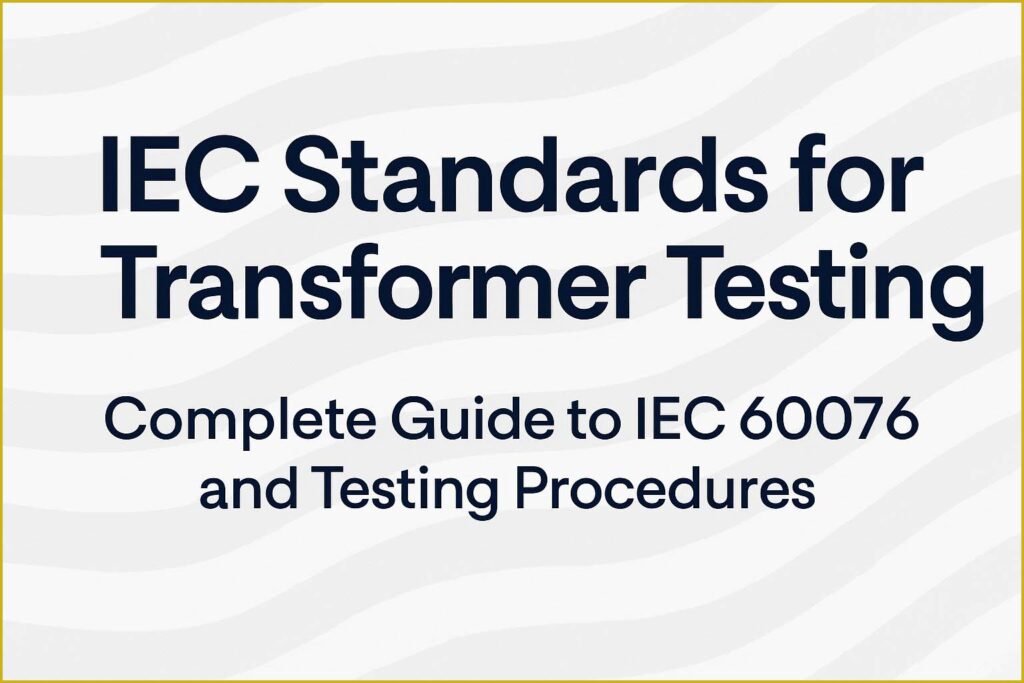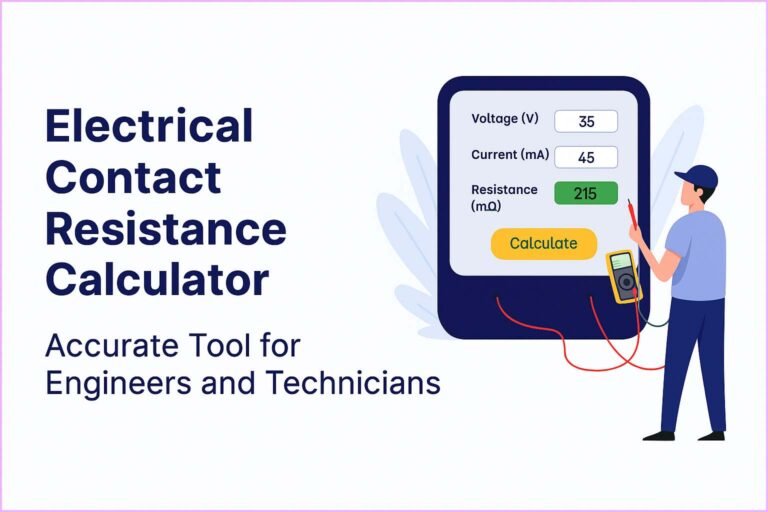IEC Standards for Transformer Testing – Complete Guide to IEC 60076 and Testing Procedures
Transformer testing is one of the most important processes in the electrical power industry. It ensures that a transformer performs efficiently, safely, and reliably under various operating conditions. To maintain quality and consistency, international standards are followed, and the most recognized among them are the IEC standards. In this article, we will explore the IEC standards for transformer testing, their importance, and the different types of tests defined under these standards.

Table of Contents
What Are IEC Standards for Transformer Testing
IEC stands for International Electrotechnical Commission. It is a global body that sets international standards for all electrical, electronic, and related technologies. The IEC standards for transformer testing define uniform procedures and performance requirements for transformers used in power systems.
These standards help ensure that transformers meet safety regulations, operate efficiently, and perform consistently across different regions and manufacturers. Transformers are critical components of power transmission and distribution networks. Their failure can cause major power outages and equipment damage. Therefore, IEC transformer testing standards are designed to verify both design and operational performance under simulated working conditions.
Importance of IEC Standards for Transformer Testing
The importance of IEC standards for transformer testing lies in their role in ensuring safety, quality, and reliability. When transformers are tested according to IEC guidelines, manufacturers and utilities can be confident that the units will function properly for years without failure.
Some key benefits of following IEC transformer testing standards include:
- Ensuring uniform quality across different manufacturers
- Preventing insulation failures and overheating
- Improving the efficiency and reliability of power networks
- Ensuring compliance with international trade and procurement regulations
- Reducing maintenance costs and power losses
Without a global standard, testing practices would vary widely, leading to inconsistent performance and higher failure rates.
Know more about earthing cable size as per iec
Overview of Common IEC Standards for Transformer Testing
Several IEC standards define specific testing procedures for power transformers. The most widely used standards are:
| IEC Standard | Title | Description |
|---|---|---|
| IEC 60076-1 | Power Transformers – General | Defines general requirements, rating, and testing principles |
| IEC 60076-2 | Temperature Rise Test | Specifies limits and methods for measuring temperature rise |
| IEC 60076-3 | Insulation Levels and Dielectric Tests | Covers high-voltage insulation and dielectric testing |
| IEC 60076-4 | Guide to Lightning Impulse and Switching Impulse Tests | Explains testing for impulse withstand capability |
| IEC 60076-5 | Ability to Withstand Short Circuit | Describes tests to verify short-circuit mechanical strength |
| IEC 60076-10 | Determination of Sound Levels | Specifies how to measure noise generated by transformers |
| IEC 60076-11 | Dry-Type Transformers | Defines testing and performance for dry-type units |
| IEC 60076-18 | Measurement of Frequency Response | Provides methods for detecting mechanical deformation in windings |
Each of these standards targets specific performance aspects of transformers. Together, they ensure that every transformer can handle electrical, thermal, and mechanical stresses safely.
Know more about IEC Standard for XLPE Cables – Complete Guide to IEC 60502 and Electrical Cable Specifications
Types of Transformer Tests under IEC Standards
IEC standards classify transformer tests into different categories. Each type serves a specific purpose in confirming transformer performance.
1. Routine Tests
Routine tests are performed on every transformer before delivery. These tests verify that each unit meets its design specifications and works safely in normal conditions.
Common routine tests under IEC 60076 include:
- Measurement of winding resistance
- Ratio and polarity check
- Insulation resistance test
- No-load and load loss measurement
- Induced overvoltage test
- Applied voltage test
Routine tests confirm that the transformer has been manufactured correctly and is ready for field installation.
2. Type Tests
Type tests are conducted on one unit of a particular design to verify that the design meets performance standards. Once the design passes these tests, it is approved for production.
Typical type tests under IEC standards for transformer testing include:
- Temperature rise test (IEC 60076-2)
- Lightning impulse test (IEC 60076-4)
- Short-circuit withstand test (IEC 60076-5)
- Sound level measurement (IEC 60076-10)
These tests simulate extreme operating conditions and confirm the design’s reliability and safety margin.
3. Special Tests
Special tests are conducted when additional information is needed or when requested by the customer. These are not mandatory but often help in detailed performance evaluation.
Examples include:
- Measurement of zero-sequence impedance
- Magnetic balance test
- Frequency response analysis
- Insulation power factor (tan delta) test
- Determination of harmonics
Special tests are usually carried out for large power transformers or for customized units installed in sensitive applications such as power stations or industrial plants.
Know more about IEC Standard for Relay Coordination – Complete Guide to Protection and Coordination Studies
IEC Standards for Transformer Insulation Testing
Transformer insulation plays a vital role in preventing internal faults and failures. IEC 60076-3 provides detailed methods for dielectric and insulation testing.
These tests include:
- Applied voltage test: Checks insulation between windings and the tank by applying high voltage for a set duration.
- Induced voltage test: Verifies turn-to-turn insulation under double frequency conditions.
- Impulse tests: Confirm the ability of insulation to withstand surges caused by lightning or switching operations.
IEC standards specify the voltage levels, test duration, and acceptance criteria for each test. Passing these ensures that the insulation can tolerate overvoltages during real-world operation.
IEC Standards for Temperature Rise Test
Temperature rise testing ensures that transformer windings and oil do not exceed safe operating limits during normal operation. According to IEC 60076-2, the temperature rise should be measured under rated load conditions.
The allowable temperature rise limits are given in the table below:
| Cooling Method | Max Winding Temperature Rise | Max Oil Temperature Rise |
|---|---|---|
| ONAN (Oil Natural Air Natural) | 55°C | 50°C |
| ONAF (Oil Natural Air Forced) | 60°C | 55°C |
| OFAF (Oil Forced Air Forced) | 65°C | 60°C |
| ODWF (Oil Directed Water Forced) | 70°C | 65°C |
These limits ensure that transformer insulation remains intact and the oil does not degrade. Excessive temperature can cause insulation breakdown and reduced lifespan.
Know more about transformer cooling methods
IEC Standards for Short Circuit Test
IEC 60076-5 outlines how to test a transformer’s ability to withstand short-circuit forces. During a fault, very high currents flow through the windings, creating large mechanical stresses.
In this test, the transformer is subjected to controlled short-circuit currents in a laboratory. The mechanical and electrical integrity is checked afterward. The transformer must show no signs of deformation, winding displacement, or insulation failure.
This test is crucial for ensuring that transformers installed in high-fault-current areas can operate safely without mechanical damage.
IEC Standards for Sound Level Measurement
Transformer noise can cause disturbances in residential and commercial areas. IEC 60076-10 defines the method for measuring the sound levels generated by transformers.
The test measures the average sound pressure around the transformer at a specified distance. The results are expressed in decibels (dB).
Reducing noise involves optimizing core design, tightening the core assembly, and using low-vibration materials. Meeting the sound level requirements ensures compliance with environmental and installation regulations.
IEC Standards for Dry-Type Transformers
Dry-type transformers are commonly used indoors and in areas where fire risk must be minimized. IEC 60076-11 defines the construction, testing, and performance criteria for these transformers.
The standard specifies tests such as:
- Thermal withstand test
- Dielectric test
- Partial discharge measurement
- Short-circuit test
Dry-type transformers have different cooling characteristics and insulation materials, so IEC provides specific guidelines to ensure their safe operation.
Know more about IEC Standard for Vibration Testing – IEC 60068 Explained with Procedures and Requirements
Emerging Trends in IEC Transformer Testing
As renewable energy integration and smart grids expand, transformer testing is also evolving. New IEC standards are being developed to address digital monitoring, condition assessment, and frequency response analysis.
IEC 60076-18, for example, focuses on Frequency Response Analysis (FRA). This test helps detect winding movement or deformation after transportation or short-circuit stress. With modern diagnostic tools, transformer condition monitoring is becoming continuous rather than periodic.
Know more about IEC Standard for Vacuum Circuit Breaker – IEC 62271 Guidelines, Ratings & Testing Explained
Why Compliance with IEC Standards Matters
Compliance with IEC standards for transformer testing is not just about meeting specifications—it’s about building trust. Utility companies, EPC contractors, and end users all rely on IEC-tested transformers for long-term performance.
Key advantages include:
- Enhanced product credibility and international acceptance
- Improved energy efficiency and safety
- Reduced warranty claims and downtime
- Easier certification and export approval
In competitive markets, adherence to IEC standards provides a significant advantage by ensuring quality assurance and customer confidence.
Conclusion
IEC standards for transformer testing provide a comprehensive framework for verifying transformer performance, safety, and durability. These standards cover every aspect of testing—from insulation and temperature rise to mechanical strength and sound level measurement.
Following IEC testing procedures helps manufacturers produce transformers that are reliable, efficient, and globally acceptable. For utilities and industries, it ensures long-term operational stability and reduced maintenance costs.
In summary, IEC standards for transformer testing are the backbone of transformer quality assurance, helping maintain a reliable and safe power infrastructure across the world.
Know more about IEC Standard for Voltage Drop Calculation: Best Guide
Follow Us on Social:
Subscribe our Newsletter on Electrical Insights for latest updates from Electrical Engineering Hub
#IECStandards, #TransformerTesting, #ElectricalEngineering, #PowerTransformer, #IEC60076, #TransformerMaintenance, #TransformerDesign, #HighVoltageTesting, #TransformerTestStandards, #EnergyEfficiency, #ElectricalSafety, #TransformerPerformance, #TestingProcedures, #EngineeringStandards, #IndustrialElectrical






